Poster: Pulse Sequence Highlights
Electronic Power Pitch Poster
Acquisition, Reconstruction & Analysis
17:15 - 18:15
Monday, 18 June 2018
Power Pitch Theater A - Exhibition Hall
| |
|
Plasma # |
|
0207.
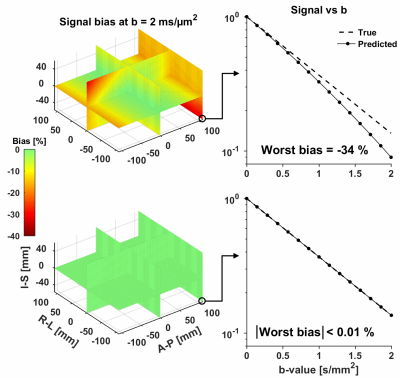 |
1 |
 Maxwell-compensated waveform design for asymmetric diffusion encoding Maxwell-compensated waveform design for asymmetric diffusion encoding
Filip Szczepankiewicz, Markus Nilsson
Asymmetric gradient waveforms enable efficient diffusion encoding but suffer from signal bias and image artifacts due to Maxwell terms (concomitant fields). We propose a novel method for generating "Maxwell-compensated" waveforms, and we demonstrate that such waveforms retain superior efficiency and exhibit negligible effects due to concomitant fields.
|
|
0208.
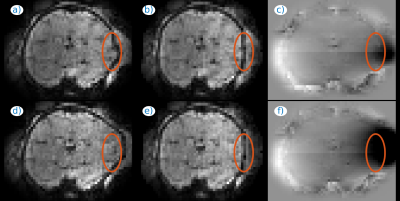 |
2 |
 Spin And Field Echo (SAFE) dynamic field correction in 3T fetal EPI Spin And Field Echo (SAFE) dynamic field correction in 3T fetal EPI
Lucilio Cordero-Grande, Anthony Price, Giulio Ferrazzi, Jana Hutter, Daan Christiaens, Emer Hughes, Jo Hajnal
A method for echo planar imaging dynamic B0 field correction based on phase unwrapping is presented. For gradient-echo functional studies, the phase of the natively acquired images is used to estimate the accumulated B0-induced dephasing. For spin-echo diffusion, a matched echo planar imaging field echo navigator is acquired after the spin-echo readout so that motion-induced phase components can be subtracted before unwrapping. Application to both functional and diffusion in-vivo 3T fetal brain imaging is illustrated.
|
 |
0209.
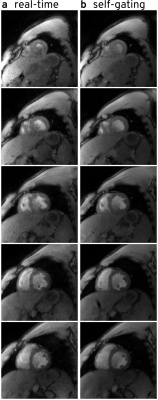 |
3 |
 Self-Gated and Real-time Simultaneous Multi-Slice Cardiac MRI from the Same Acquisition Self-Gated and Real-time Simultaneous Multi-Slice Cardiac MRI from the Same Acquisition
Sebastian Rosenzweig, Hans Christian Martin Holme, Nick Scholand, Robin Wilke, Martin Uecker
Cardiac MRI requires fast and robust acquisition and reconstruction strategies to generate clinically reliable results. Using a combination of non-aligned radial Simultaneous Multi-slice (SMS) acquisitions and Regularized Nonlinear Inverse reconstruction, time-consistent movies of multiple slices can be generated. Here, we develop a self-gating technique for real-time radial SMS measurements which allows for the reconstruction of high-quality self-gated cine loops in addition to real-time movies from the same measurement.
|
 |
0210.
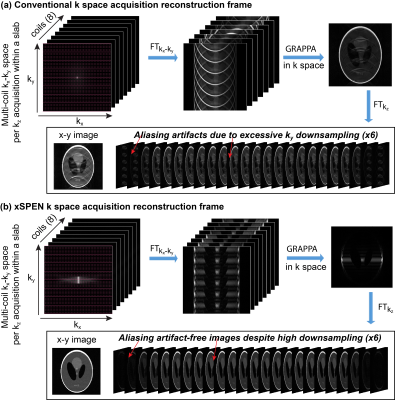 |
4 |
 Phase Encoded xSPEN: A High-Definition Approach to Volumetric MRI with Unusually High Acceleration Factors Phase Encoded xSPEN: A High-Definition Approach to Volumetric MRI with Unusually High Acceleration Factors
Zhiyong Zhang, Michael Lustig, Lucio Frydman
xSPEN is a single-shot MRI approach whose timing and pre-acquisition hyperbolic phase, endow it with exceptional resilience to offsets. We recently introduced multi-scan, phase-encoded (PE) 3D xSPEN MRI which preserves this while increasing resolution along the PE (y) and slab-selection (z) dimensions. It is here shown that parallel receivers endow this 3D approach with unprecedented PE downsampling performances. This reflects xSPEN’s unusual kernel, whose hyperbolic phase couples the directly-sampled kzinformation with the y coil sensors. This mitigates the artifacts associated with a highly undersampled ky axis, as demonstrated by highly accelerated in vitro and human scans.
|
 |
0211.
 |
5 |
 Accelerated T2-Weighted Imaging of the Abdomen with Self-Calibrating Wave-Encoded 3D Fast Spin Echo Sequences Accelerated T2-Weighted Imaging of the Abdomen with Self-Calibrating Wave-Encoded 3D Fast Spin Echo Sequences
Feiyu Chen, Valentina Taviani, Joseph Cheng, John Pauly, Shreyas Vasanawala
In this work, a self-calibrating wave-encoded 3D FSE technique was proposed with self-refocusing gradient waveforms and autocalibrated estimation of wave-encoding point-spread-function and coil sensitivity maps. Compared to conventional Cartesian approach at the same acceleration factor, the proposed method achieves reduced artifacts and better anatomical delineation for highly undersampled abdominal imaging. It enables 10-fold acceleration for 3D FSE scans of the abdomen, allowing 3D FSE sequences to be less sensitive to subject motion.
|
 |
0212.
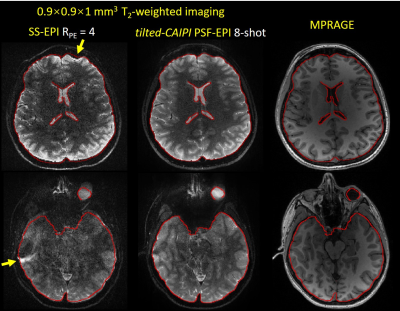 |
6 |
 Tilted-CAIPI for Highly Accelerated Distortion-Free EPI with Point Spread Function (PSF) Encoding Tilted-CAIPI for Highly Accelerated Distortion-Free EPI with Point Spread Function (PSF) Encoding
Zijing Dong, Fuyixue Wang, Timothy Reese, Mary Manhard, Berkin Bilgic, Lawrence Wald, Hua Guo, Kawin Setsompop
The main challenge in high-resolution EPI is the significant B0-distortion and T2*-blurring artifacts. PSF-encoded EPI has been proposed to achieve distortion- and blurring- free imaging at a cost of extremely long acquisition time, not practical for most applications. In this work, we introduce the “tilted-CAIPI” method, which can provide >20x acceleration for PSF-EPI by utilizing the concept of B0-inhomogeneity encoding and optimized sampling. With the proposed method, PSF-encoded EPI at a 1mm resolution range can be obtained using just 4-8 EPI-shots. PSF-EPI with tilted-CAIPI was demonstrated for efficient acquisition of distortion- and blurring- free T2-weighted, T2*-weighted, and diffusion-weighted images.
|
 |
0213.
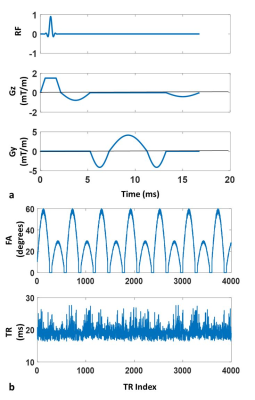 |
7 |
 Silent MRF : Quantitative scan with reduced noise using the Magnetic Resonance Fingerprinting (MRF) framework Silent MRF : Quantitative scan with reduced noise using the Magnetic Resonance Fingerprinting (MRF) framework
Dan Ma, Bhairav Mehta, Mark Griswold
Because MRF provides a flexible framework without any requirement for constant repetition times or gradient amplitudes, we propose to use arbitrary gradient waveforms and randomized TR times to reduce the acoustic noise, while still providing quantitative 3D T1 and T2 values.
|
|
0214.
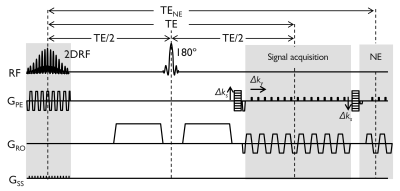 |
8 |
 Focused, High-Resolution, Distortion-Free Diffusion Imaging Focused, High-Resolution, Distortion-Free Diffusion Imaging
Myung-Ho In, Yi Sui, Joshua D Trzasko, Yunhong Shu, Shengzhen Tao, Erin M Gray, John Huston, Matt A Bernstein
This study reports focused, high-resolution, distortion-free diffusion imaging using a combination of DIADEM (Distortion-free Imaging: A Double Encoding Method) and reduced field-of-view (rFOV) imaging. DIADEM is a hybrid, multi-shot approach inspired by the point-spread-function mapping technique for distortion-free imaging. The multiple-shots effectively signal average and compensate for the reduced image SNR resulting from the rFOV. The rFOV reduces the number of phase-encoding steps, which shortens the scan time, making it more clinically feasible. The results demonstrate focused distortion-free diffusion images with a high in-plane resolution (0.86 mm2), which could provide improved anatomic depiction of local brain tissue structures.
|
 |
0215.
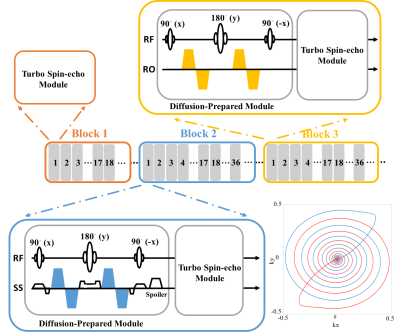 |
9 |
 DP-TSE MRF: Rapid and Accurate T2 and ADC Quantification Using Diffusion-Prepared Turbo Spin-echo Magnetic Resonance Fingerprinting DP-TSE MRF: Rapid and Accurate T2 and ADC Quantification Using Diffusion-Prepared Turbo Spin-echo Magnetic Resonance Fingerprinting
Zhixing Wang, Xiaozhi Cao, Congyu Liao, Huihui Ye, Hongjian He, Jianhui Zhong
This study proposes a rapid and accurate MR fingerprinting (MRF) framework based on a diffusion-prepared, turbo spin-echo (DP-TSE) sequence. Compared to both conventional parametric mapping and recent FISP-based MRF methods, the proposed framework provides accurate T2 maps and three main apparent diffusion coefficients (ADCs) for 15 slices within 7 minutes. This new MRF strategy can achieve accurate, inherently co-registered, high resolution T2 and ADC maps simultaneously.
|
|
0216.
 |
10 |
 Shuttered EPI Brain Imaging at 7 Tesla Shuttered EPI Brain Imaging at 7 Tesla
Saikat Sengupta, Kawin Setsompop, William Grissom
Achieving robust sub-millimeter resolution EPI at 7 Tesla is a challenge since conventional single shot images suffer from long echo times and severe image distortions, while multishot EPI suffers from motion- and respiration-induced shot-to-shot phase errors. Recently, Taviani et al described an ‘in-plane multiband’ or ‘shuttered EPI’ method for 3T breast diffusion imaging, in which data are acquired in each shot after exciting a set of shutters across the imaged slice and combined using a phase- and motion-insensitive reconstruction. Here we present an implementation of this approach for high-resolution 7T brain imaging, which required a new RF pulse construction.
|
 |
0217.
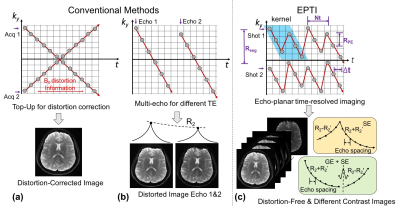 |
11 |
 Echo Planar Time-resolved Imaging (EPTI) Echo Planar Time-resolved Imaging (EPTI)
Fuyixue Wang, Zijing Dong, Timothy Reese, Berkin Bilgic, Mary Manhard, Lawrence Wald, Kawin Setsompop
A new technique, termed Echo Planar Time-resolved Imaging (EPTI), was developed to address EPI’s geometric distortion and blurring, and to provide new temporal signal evolution information across the EPI readout window. Using only a few shots, a time-series of multi-contrast images can be created free of distortion and blurring (up to 100 T2- and T2*-weighted images with time interval of an EPI echo spacing). This should make EPTI useful for numerous applications where undistorted images across multiple-contrasts are desired. We demonstrated EPTI in brain to simultaneously map T2, T2*, and tissue phase, as well as to provide SWI.
|
|
0218.
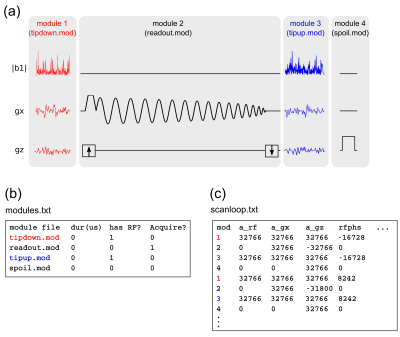 |
12 |
 TOPPE: A framework for rapid prototyping of MR pulse sequences TOPPE: A framework for rapid prototyping of MR pulse sequences
Jon-Fredrik Nielsen, Douglas Noll
We present a simple MR pulse programming framework for rapid prototyping of complex, custom MR pulse sequences. We define a file format that contains all low-level details of an MR imaging experiment, along with a driver (or interpreter) that loads the file(s) and executes the experiment on a General Electric scanner. We demonstrate that a wide range of sequences can be implemented with this setup, subject to limitations such as non-overlapping waveforms. Our framework is conceptually similar to Pulseq, a recently-introduced file format specification for which drivers for other vendor platforms exist (at present, Siemens and Bruker).
|
 |
0219.
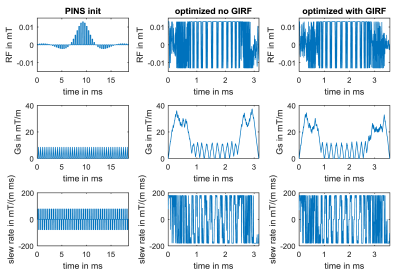 |
13 |
 Time-optimal control based RF pulse design under gradient imperfections Time-optimal control based RF pulse design under gradient imperfections
Christoph Aigner, Armin Rund, Samy Abo Seada, Shaihan Malik, Joseph Hajnal, Karl Kunisch, Rudolf Stollberger
We demonstrate the joint design of minimum duration RF and slice selective gradient shapes with included gradient impulse response function (GIRF) to correct for non-ideal slice selective gradients in the pulse design. The proposed time-optimal control method designs slice selective gradient shapes with matched RF shapes for the distorted slice selective gradient. Phantom experiments on a 3T scanner validate the optimized results and demonstrate the successful correction of gradient imperfections with the proposed approach.
|
 |
0220.
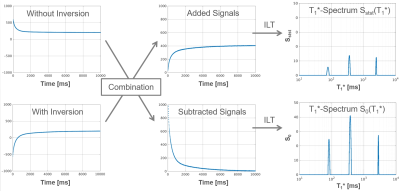 |
14 |
 Fast multi-component T1 and T2 correlation measurements using steady-state free precession Fast multi-component T1 and T2 correlation measurements using steady-state free precession
Julian Pfister, Felix Breuer, Peter Jakob, Martin Blaimer
An inversion recovery bSSFP measurement allows to generate a spectrum of the apparent relaxation time T1* and hence to identify multiple components in a voxel. However, it is not possible to extract unambiguous T1 and T2 information for each individual component. Here, we demonstrate that this limitation can be overcome by an additional bSSFP measurement without inversion pulse. Additive and subtractive combinations of the measured signal courses provide enough information for assigning unambiguous T1, T2 and proton density values to each component. In that way, 2D T1-T2 correlation spectra can be generated voxel-wise in a very time-efficient manner.
|
|
0221.
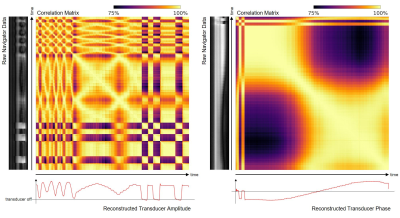 |
15 |
 MEG-Navigators for Motion Detection and Quality Assurance in MR Elastography MEG-Navigators for Motion Detection and Quality Assurance in MR Elastography
Christian Guenthner, Sebastian Kozerke
We propose to use the motion encoding gradients (MEGs) of a conventional 3D GRE-MRE sequence as efficient 1D projection navigators with only minor changes to the sequence timing. We show that MEG-NAVs can be used to detect breathing motion, flexing of the thigh muscle, as well as changes in magnitude and phase of the MRE transducer. The additional MEG-NAV data can be used to check breath-hold compliance in conventional GRE-MRE liver exams as well as to ensure optimal transducer operation.
|
|

 Watch the full Pitch Session Here
Watch the full Pitch Session Here















